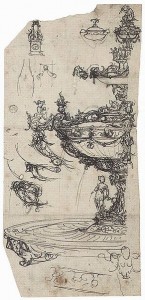
Although the official start of the new year in Tudor times was 25th March, “Lady Day” or the Feast of the Annunciation of the Blessed Virgin, the Roman tradition of New Year was celebrated on 1st January and it was traditional for courtiers to give gifts to the monarch. These gifts were recorded annually in the gift roll. In 1534, for example, we know that the King received, amongst other gifts of plate and pots:
“a silver gilt compass, 69¾ oz., a goodly table of Hercules, a table of Our Lord, a tablet of gold with an antike face, a prymer of written hand in vellum, a goodly clock, an “esposier” of gold with a chain, a goodly table of St. Jerome, a tablet of gold with a device of Venus and Cupidoo, two “seviettes” and a marmoset.”
The King also gave gifts to his courtiers. In January 1532, he gave his sister, Mary Tudor ‘the French queen’, “a pair of gilt pots. (Morgan Woulf), 82½ oz., and a gilt cup with a cover (Freman’s), 19¼ oz” and his daughter, Princess Mary, “2 gilt pots. (Cornelles), 102 oz. 3 gilt bowls with a cover (Cornelles), 104 oz. A gilt layer. Amadas, 125/8 oz.”. In return, his sister gave him “a pair of writing tables with a gold whistle”.
In January 1533 (the same month that Anne and Henry secretly married), the King spoiled his Queen-to be with a long list of gifts:
“Warrant under the King’s sign manual to Cromwell, master of the Jewels, to deliver to the lady of Pembroke [Anne Boleyn] these parcels of gilt plate, late of Sir Henry Guldeford, controller of the Household :—2 gilt pots with round knobs behind the lids, which came to Sir Henry as executor to Sir William Compton, weighing 133 oz. ; a pair of gilt flagons with the arms of France, 147 oz. ; 6 gilt bowls without a cover, 200½oz. ; 3 gilt salts with a cover of Parres touch,” which belonged to Sir Will. Compton, 77 oz. ; 12 gilt spoons with demi-knops at the end, 18 oz. ; a pair of parcel-gilt pots, 99½ oz. ; another, 97¾ oz. ; another, 71 oz. ; 6 parcel-gilt bowls without cover, 199¼ oz. ; the cover of the same, 19¾ oz. ; a basin and ewer, parcel-gilt, 77 oz. ; another basin and ewer, parcel-gilt, 64 oz. ; 11 white spoons with roses at the ends, 20¼ oz. ; 4 candles, white, with high sockets, 86½ oz. ; “a round bason of silver for a chamber, and a silver pot to the same, weighing together 138½ oz.” ; and a chafing dish, parcel-gilt, 39¾ oz. “And that ye make entry of the foresaid parcels of plate into our book of Extra for the rather noticing the same hereafter.” Greenwich, 1 Jan. 24 Hen. VIII.”
And a year later Queen Anne Boleyn gave her husband a beautiful silver-gilt table fountain which she had commissioned from Hans Holbein the Younger, the famous Renaissance artist. Eric Ives writes of how it was “a pumped device which circulated rosewater into a basin so that diners could rinse their hands” and it is described in the gift roll as “a goodly gilt bason, having a rail or board of gold in the midst of the brim, garnished with rubies and pearls, wherein standeth a fountain, also having a rail of gold about it garnished with diamonds; out thereof issueth water, at the teats of three naked women standing at the foot of the same fountain.” How wonderful!
Not all gifts were welcome, however. In 1532, Eustace Chapuys, the Imperial ambassador, wrote to the Emperor of Catherine of Aragon’s gift to her husband, the King:
“The Queen having been forbidden to write letters or send messages to the King, and yet wishing to fulfil her duty towards him in every respect, caused to be presented to him on New Year’s Day, by one of the gentlemen of the chamber, a gold cup of great value and singular workmanship, the gift being offered in the most humble and appropriate terms for the occasion. The King, however, not only refused to accept the present, but seemed at first very angry with the gentleman who had undertaken to bring it. Yet it appears that two or three hours afterwards the King himself desired to see the cup again, praised much its shape and workmanship, and fearing lest the gentleman of his chamber who had received it from the Queen’s messenger should take it back immediately—in which case the Queen might have it presented again before the courtiers (devant tout le monde), when he (the King) could not well refuse its acceptance—he ordered the gentleman not to give the cup back until the evening, which was accordingly done, and it was then returned to the Queen. The King, moreover, has sent her no New Year’s gift on this occasion, but has, I hear, forbidden the members of his Privy Council, as well as the gentlemen of his chamber, and others to comply with the said custom.”
The King, instead, sent Anne Boleyn, who was lodged in the Queen’s former lodgings, “rich hangings for one room, and a bed covered with gold and silver cloth, crimson satin, and embroidery richer than all the rest”. He obviously saw Anne as his consort.
If you want to read the gift rolls, which give a fascinating insight into court life and who was in favour, then here are a few links for you:
I’d like to take this opportunity to wish you a very Happy New Year and to thank you for all your support during 2012. Happy New Year!
Notes and Sources
- LP v.686
- LP vi. 6
- LP vii. 9
- Calendar of State Papers, Spain, Volume 4 Part 2, 880
- The Life and Death of Anne Boleyn, Eric Ives, p148